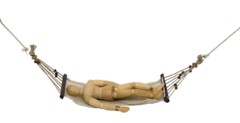You
Blew What?
by Phil Kaplan
Three
words ring out days or weeks after January 1st - "I
blew it."
Blew
what?
The
resolution. The diet. The promise. The exercise plan. The quest
for health. The pursuit of fitness.
 The
words aren't limited to the onset of a new year. They arrive
after commitments to betterment run into an acceptance of a
failed attempt. They arrive after a promise to change is followed
by abandonment of the promised journey.
The
words aren't limited to the onset of a new year. They arrive
after commitments to betterment run into an acceptance of a
failed attempt. They arrive after a promise to change is followed
by abandonment of the promised journey.
Here's
my take on blowing it. You've only blown it if you stop, and
fail to start with a new attempt or a modifcation in the approach.
You've only blown it if you stop learning and acting. I'm not
going to give you the "Thomas Edison failed umpteen thousand
times before he invented the lightbulb" story, or the "Sylvester
Stallone was rejected for Rocky again and again and again"
saga. Instead I'll put it on you with a simple question.
Do
you really want it?
If
"it" is better health, better fitness, better confidence,
better well-being, better muscularity, better sexuality, better
performance, or better all around sense of power, you know you
really want it.
 Most
people blow it. You don't want to be most people. You may, however,
find comfort among the masses. You're certainly not alone if
you resign yourself to "I tried."
Most
people blow it. You don't want to be most people. You may, however,
find comfort among the masses. You're certainly not alone if
you resign yourself to "I tried."
Oh,
there are lots of excuses, and many of them are "good ones."
You might have been diagnosed with a "condition."
Perhaps you blame your thyroid, your parents, your hormones,
or your spouse. Perhaps your family doesn't enjoy "healthy
foods" or your job requires that you eat donuts.
Excuses
support the non-phenomenon of "blowing it." They are
thoughts that may, in the moment, make you OK with what would
have otherwise been a blatant sense of failure. If you want
to wallow in those excuses, if you want to coddle those thoughts
and allow them to recirculate, and if you want to rationalize
by deciding there are others worse off than you so what's the
big deal if you find comfort in Edy's Grand . . . every night
. . . far be it from me to challenge you. All I ask is that
you accept that you're making a choice.
I'll
make a promise. You can be better. I'll make another promise.
If you want to be better, it's in your court. I know you can,
only because I understnad the human machine. I understand metabolism.
I understand the process of positive physical change. If you
want to gain some new momentum, if you want to kick the excuses
to another universe, then a few forward steps can ensure that
you never blow it again.
THE
MISTAKES
There
are three massive mistakes that are so common almost everyone
I consult with has made them:
Any
of those ring true for you? Let's try a few things.
Imagine
a Hammock . . .
 Consider
that, thanks to his brain, his heart, and his internal organs,
a healthy, metabolically efficient 150 pound man lying in a
hammock would burn about 1500 calories in a 24 hour period.
Keep in mind, that's if he's completely tranquil. Throw in thoughts
of his girlfriend, stress over money, or a bit of anxiety and
his need increases. If this buck-and-a-half fellow is going
to sustain his metabolic requirements, on days that he incorporates
thought, interaction, and activity, he has to consume well over
the 1500 calories he'll burn lying still to keep himself functioning
on all cylinders.
Consider
that, thanks to his brain, his heart, and his internal organs,
a healthy, metabolically efficient 150 pound man lying in a
hammock would burn about 1500 calories in a 24 hour period.
Keep in mind, that's if he's completely tranquil. Throw in thoughts
of his girlfriend, stress over money, or a bit of anxiety and
his need increases. If this buck-and-a-half fellow is going
to sustain his metabolic requirements, on days that he incorporates
thought, interaction, and activity, he has to consume well over
the 1500 calories he'll burn lying still to keep himself functioning
on all cylinders.
Now,
let's suppose this 150 pounder dcides he's going to, diet, to
cut back, to consume 800 calories a day. Will he die? Not likely.
He'll survive. His body, absent the food it wants for, will
opt to create fuel from amino acids, and after a short while,
it will consume muscle tissue as energy. That's a win if his
only goal is survival, especially because the reduction in muscle
reduces his caloric need. In addition, his endocrine system
will work to avoid starvation by adjusting production of thyroid
hormones and slowing metabolism. Eventually, he'll have reset
his metabolic thermostat so in a modified body, with a slower
metabolism, he survives on 800 calories. I said that's good
. . . if survival is the goal . . . but if the 150 pound man
doesn't want to get fat . . . the muscle loss and endocrine
shift is anything but good. Eventually, he'll go back to eating
more, and the 1500 calories that once sustained him in a state
of extended rest, will now lead to the accumulation of fat (he
has a slower metabolism). With repetitive bouts of dieting,
he'll gradually turn himself into a fat guy who says, "I'm
going to start my diet on New Years Day," and by mid-February
winds up "blowing it."
But
Phil, I'm not a 150 pound man!
The
illustration using the 150 pound man becomes even more disheartening
when we apply it to someone who begins the process in an overweight
condition. The reduction in calories slows an already compromised
metabolism and as muscle diminishes, the body programs itself
to become quite efficient at adding fat.
 What
does all of this mean? It simply means a calorie restrictive
diet is NOT going to be a solution if long term healthful
fat loss is a goal . . . thus . . . failing to eat enough without
an understanding of the inetbitable is an element leading to
perceived failure. Soup diets, lemon juice diets, low-calorie
shake diets, and appetite suppresants all work against the human
body's innate ability to "burn through" food efficiently.
Calorie reduction will almost always lead to short term weight
loss followed by not only a rebound but a decline in metabolic
efficiency.
What
does all of this mean? It simply means a calorie restrictive
diet is NOT going to be a solution if long term healthful
fat loss is a goal . . . thus . . . failing to eat enough without
an understanding of the inetbitable is an element leading to
perceived failure. Soup diets, lemon juice diets, low-calorie
shake diets, and appetite suppresants all work against the human
body's innate ability to "burn through" food efficiently.
Calorie reduction will almost always lead to short term weight
loss followed by not only a rebound but a decline in metabolic
efficiency.
Ideally,
someone seeking fat loss will consume frequent meals made up
of delicious (yes, I said delicious) combinations of lean proteins,
natural slow-release carbohydrates, and fresh fruits and vegetables.
Frequent meals throughout the day help to supply fuel and materail
for building new healthy cells.
Most
people who come to understand the "synergy" that combines
supportive eating with the right type of exercise are initially
shocked by the volume of food they consume as they lose fat.
The most valuable supplement for most people trying to make
the shift to Supportive Nurition is a
meal replacement formula, a powder that can provide the
nutrients you'd hope to get in a supportive meal (see EAT! Pro!
link at right).
Maybe
you've been with me for some time. Maybe you attended one of
my seminars. Maybe you've heard this before.
Good.
If it didn't sink in yet, and you "blew it," unblow
it! Apply it now, and know that supportive eating is only one
of three pieces of the synergy.
That
leads to further exploration of mistake #2, too much exercise,
too little recuperative downtime.
But
lots of exercise can't be bad . . . can it?

This
will shock you.
While
any exercise is better than sitting on the couch, "too
much" is absolutely a mistake, and anyone who's spent any
time in health clubs understands the apparent paradox of the
"fat-skinny" person. Too much aerobic exercise
is not unlike calorie deprivation in the effect it has on body
composition (muscle loss). A reliance on high volume aerobic
exercise without adequate intake of calories is a sure-fire
way to become one of those people who says, "I weigh
the right thing, I look great in clothes . . . but the beach?!?!
No way!"
Now
the shocking part. I am having the best success in boosting
endurance and in burning fat by taking my clients through 12-minute
aerobic sessions.
Yes,
12 minutes.
I
know it flies in the face of convention. I know it goes against
everything you've heard about "burning glucose first and
not releasing fat until you've spend 15-20 minutes in your target
zone." Despite the fact that your treadmill screen says
something about "fat burning zone," Here's what I
say. If your present program failed you, and the 12-minute thing
is working, consider that there may be more to the picture than
simply exercising at a continuous extended pace at a percentage
of max heart rate. The 160 clients who have gone through my
pilot program all agree . . . it's working! Sure it goe sagainst
convention, but it is backed by science . . . and . . . look
at our population before you assume convention is working.
The
12 minute sessions including metabolic "pumps," short
duration all-out efforts where the clients kick the energy output
to their perceived max for 12-15 second bursts (think sprint).
This seems to activate the "fight or flight" systems
and amplify the production of catecholamines. It sparks a release
of "fuel" and allows for enhanced fat burning. It
also, over an 8-week period, has been consistent in increasing
VO2 Max, a measure of aerobic endurance.
 The
short sessions allow for individuals with active lives and fair
amounts of stress to recuperate adequately. Long duration frequent
intense workout may require a full 8 hours of sleep and a sufficient
management of stress to allow for an optimal internal environment
for fat release and health.
The
short sessions allow for individuals with active lives and fair
amounts of stress to recuperate adequately. Long duration frequent
intense workout may require a full 8 hours of sleep and a sufficient
management of stress to allow for an optimal internal environment
for fat release and health.
I
said there are three pieces to the Synergistic process that
"works," the first piece being supportive eating,
the second piece being moderate aerobic exercise, and the third
part I've always called . . .
A
Concern for Muscle.
Here
too, most of those who try and fail do far too much. The resistance
portion of the ALIVE protocol, the protocol I'm using to help
people find movement toward their physical best, typically incorporates
6 - 8 movmeents and workouts that rarely exceed 20 minutes.
Conventional?
No.
Effective?
You bet.
That
leaves us with one more mistake to explore . . .
False
Expectations and Failure to Follow Through
The
explosion of diets over the past decade and the emergence of
fitness magazines, websites, infomercials, and supplement ads
have contributed to the blaring repetition of an all-too-familiar
theme. "It's quick." Stimulants, appetite suppressants,
drugs, and extremes have reinforced the illusion, and the tricks
that lead to rapid loss of pounds are the same hazards that
lead to a sense that the program "stopped working."
Quick weight loss is always going to be water loss, and continued
quick weight loss is going to almost always include loss of
muscle. Quick muscle gain using prohormones or anabolic drugs
are almost always going to be short-lived or, reliance upon
hormone and drugs may cause lasting compromise of the endocrine
system. Because people "see" quick results, they believe
they too should achieve dramatic changein unreasonably shor
ttime periods.
21
days is enough time to note improvement if you have a fair gauge
for progress. 8 weeks is enough to show dramatic change. 17
weeks is enough for most people to recognize that they are not
only better, but far better than they anticipated. Of course,
the time period only leads to thrilling results if the approach
is sound, if the synergy of positive physical change is respected
and employed.
If
you made it this far, I know you're in touch with your sense
of want, and now you have a bit of new information. If you've
been plagued by one of more of the mistakes, you need only to
make some shifts to move toward the betterment you want for.
I'm
here to help. The Synergy you'll rely upon is outlined completely
in all of my programs. Whether you opt for ALIVE, the ANSWER,
Transform, the remote 21 Day Journey, or one of my live programs,
I'll make you one more promise. Betterment begins when you accept
new possibility and take a step forward with a true technology
of physical change. I've been sharing that technology now for
over 25 years. Put excuses to bed, allow the past to be the
road that led you here, and get started on a program that can
take you to true excellence.

